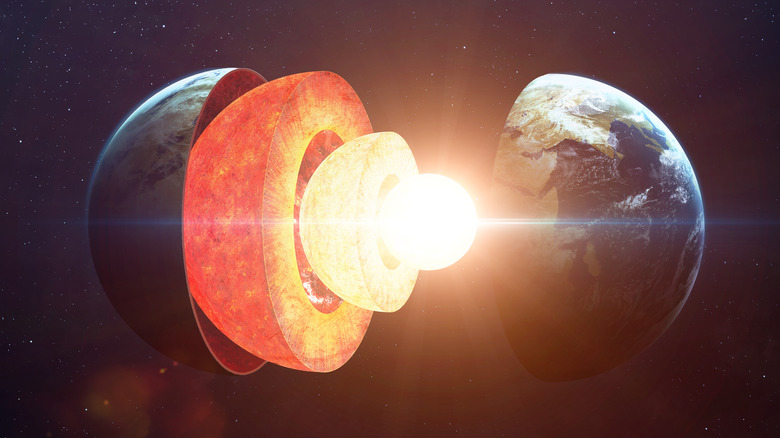Earth's Inner Core Has Another Layer Inside: A Gigantic Metal Ball
Even folks who didn't pay too much attention in elementary school science class might remember that Earth isn't just a dumb ball of cold, solid stone spinning in an even dumber, colder void of space. Earth has layers, and we just happen to be standing on the outermost surface, the rocky crust. The crust is Earth's thinnest layer, composed of tectonic plates that slide and shift on the roiling, gooey mantle below, as Space.com outlines. Beneath the mantle, which itself is layered, lies the core. The outer core — 1,367 miles thick and up to 9,932 degrees F — is made of iron and nickel. It swirls around the cooler, more solid inner core and creates a dynamo that generates the magnetic shield keeping Earth safe from cosmic radiation. Pretty cool stuff.
And ... that's it, right? School textbooks are all written, university curricula finalized, and articles like the aforementioned Space.com piece written. Or at least, we thought we were done until a pair of seismologists at the Australian National University made a discovery that's rendered every single portrait of Earth's core obsolete.
Published in the journal Nature Communications on February 21, 2023, and available on Nature online, it comes with the slightly ungainly title, "Up-to-fivefold reverberating waves through the Earth's center and distinctly anisotropic innermost inner core." Stated as simply and straightforwardly as possible, this means that Earth has another layer. As The Washington Post clarifies, there's another smaller, solid, crystalline iron-nickel innermost inner core at the heart of our planet.
The innermost inner core
Okay, "innermost inner core" isn't the best title for the newly discovered layer of our home planet, but let's consider it a work in progress. That being said, researchers have had a bit of time to come up with something better; they've suspected the existence of such a layer for at least 20 years or so, as a 2002 study published in the Proceedings of the National Academy of Sciences of the United States of America (PNAS) describes. But real science and data collection take time, especially because seismologists need to wait for earthquakes to happen to analyze what's going on in the innermost parts of Earth.
In the current study, researchers Thanh-Son Pham and Hrvoje Tkalčić used seismometers — instruments that measure oscillations of seismic waves — to track the reverberations caused by earthquakes, as The Washington Post explains. Remember that Earth is composed of nested layers that are constantly rumbling, roiling, and shifting. When disturbances in these layers shiver all the way to the surface of the planet and cause an earthquake — kind of like a bell being rung — we get aftershocks that continue to hum after the fact. Shock waves bounce back and forth from one side of the planet to the other and pass through the core along the way. This time researchers spotted changes to the vibrations that indicate another, separate innermost inner core inside the planet.
The creation of Earth's magnetic shield
As the published results in Nature say, Thanh-Son Pham and Hrvoje Tkalčić took readings from three seismic events at Alaska's Sandwich Island back in 2018 using multiple research stations from around the world. The team tracked oscillations that passed through Earth's center five times, whereas Pham says that other studies sometimes only measured one bounce, as The Washington Post quotes.
As for the new layer itself, Pham said that the difference between the inner core and innermost inner core isn't as dramatic as the difference between the mantle and the core, for instance. If you were able to somehow visually burrow through Earth's layers, things might not look too, too different once you hit the newly discovered innermost inner core, except that the innermost inner core is composed of a different crystalline structure of iron and nickel.
And what does this mean for understanding our planet and its creation? The innermost inner core, aside from whatever further analyses reveal, tells us about the Earth's ever-important, cosmic radiation-absorbing magnetic shield. Geophysicist John Tarduno speculates that the innermost inner core formed in conjunction with changes to the layers above it as recently as hundreds of millions of years ago. Big chunks of the crust sank into the mantle, he says, and altered the flow of heat in the core. This not only helped create the innermost inner core but also Earth's entire magnetic shield dynamo.


